Last year I joined a napkin exchange as an impetus to try some new weaving techniques. Since I don’t use cloth napkins — or at least I didn’t until I got a whole bunch of handwoven ones 🙂 — this year I decided to join a towel exchange. I wasn’t particularly wanting to try new weaving techniques, but did want to weave with some unmercerized cotton to see how it behaved differently from the mercerized I’ve worked with.
I decided on 3 colors, played with my brand new Mac version of Fiberworks (YAY!), figured out a draft, and ordered the cotton.
A generous member of my fiber arts guild loaned me her warping mill so I could try it out for this long and wide warp.
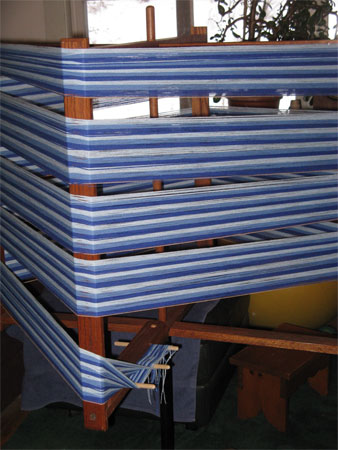
No doubt the warping mill is much quicker than my warping board, but I’m not in love with it. I’m guessing that some of that is because I’ve only used one once so would need to develop familiarity, and some is due to the specifics of this handmade mill. In any case, I’m not ready to run out and get one.
I would a warp of 547 ends for 10 towels, set up my 8 harness Macomber loom (it took 4 hours!!! since the unmercerized isn’t the easiest fiber — but not as difficult as rayon chenille in the width and length would have been) and went on my merry way.
I used a 3/1-1/3 twill, getting the maximum amount of color interplay between the 3 shades of blue.
Here’s the first towel on the loom.

I do like the way the colors are interacting; I don’t like working with three shuttles. It’s SO much slower than working with one, or even two colors. For the first towel I started two colors on one side, one on the other in an effort to minimize any mess of carrying threads up one side.
This was so tedious, for the next one I decided I’d start them all on the same side and minimize the time spent wrapping the threads around at the selvedge. I didn’t much care for that, either.
For the third and fourth towels I used the same pattern, but cut the threads after each color. This seemed more pleasurable, but it still wasn’t my favorite thing to do.
So for towel #5 I picked out another unmercerized cotton I had and used it for the entire weft.
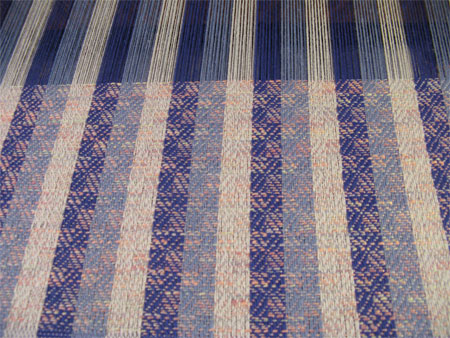
This is a variegated cotton slub with a tiny bit of nylon in it for a bit of shine. I enjoyed working with only one weft, but the pattern didn’t really show up well. So I figured what the heck, for towel #6 I’d try this weft in a plain weave.
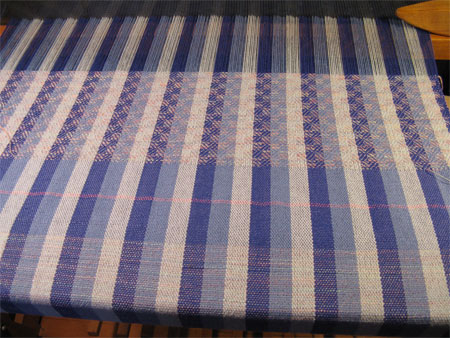
Now the color really doesn’t show, but it sure is quick & easy to weave!
So for the rest of the towels, I went back to using all three colors. But a bit differently. For towels #7 & 8 I went through the treadling pattern three times instead of once, so I change colors only 1/3 as often. I like this, too.
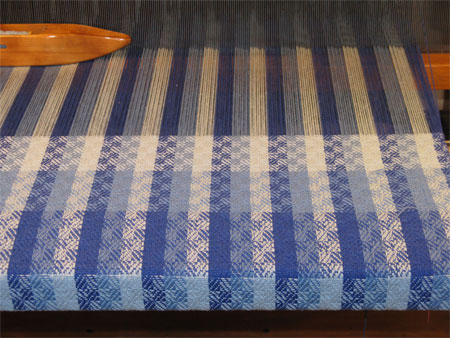
For towel #9 I modified the treadling pattern for wider blocks of each twill. I’m not as fond of it.
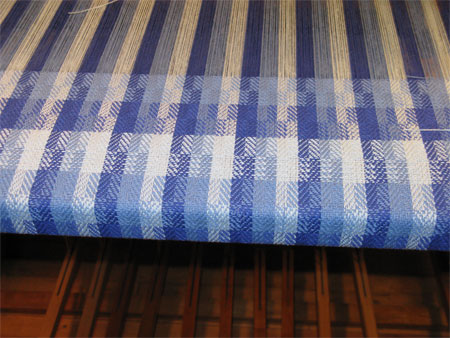
So for the very last towel I went back to plain weave. I thought it might look interesting in someone’s kitchen if I wove half of it with the darkest weft and half with the lightest.
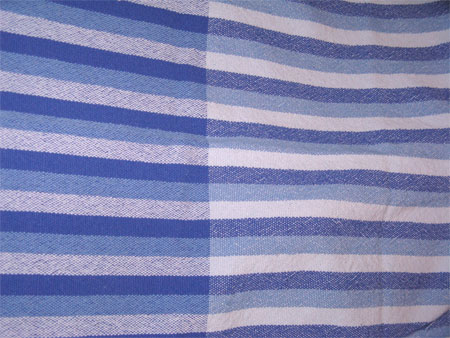
All went well (in relative terms; I’m having Macomber issues, but that’s a topic for another post) until I cut them off the loom and took them up to the sewing machine to run a line of machine stitching along the to-be-cut edges prior to hand hemming.
Uh oh! Clearly I skipped two critical steps: (1) checking for floats with the computer program and (2) sampling. As I’ve said previously, I hate sampling. I usually avoid drafting problems by remembering to check for floats on the computer. How could I have forgotten it now?!
As a result, I have some long floats on the back. Some up to 9 threads. Yikes! Well, what’s done is done. Throw these babies into the washer on hot water, then the dryer, and see what happens. Luckily I wasn’t planning to sell any of the towels — 6 for the towel exchange and 4 for gifts — but still, who wants her less-than-great work out there in public? No one.
After the towels come out of the dryer the shrinkage is enough that although I’m not happy with the floats, I’m no longer as embarrassed by them that I’m not willing to use them as planned. I’m in the hemming phase now; three are done, seven to go.
Here’s my draft. WARNING — DO NOT USE IT AS IS!!! The simple removal of harness 4 on treadle 4 and harness 5 on treadle 5 will solve the problem, although it will change the looks a bit.
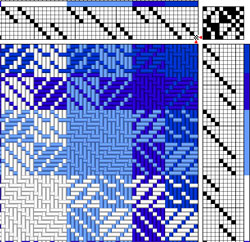
Your turn: what have you been up to lately?


To fix the float problem, I would make the blocks symmetrical, which would involve four changes in the tie-up. Three of the changes would involve untying a shaft from a treadle, and the other change would be to tie one shaft to a treadle.
In the top left box in the tie-up (I call it treadle 1), I would eliminate that dark box.
In the second column from the left (treadle 2), I would eliminate the dark box fourth from the top.
That would leave four dark boxes diagonally across that block.
In the block below it in the tie-up box, I would add a dark box at the bottom of the third column.
Remove the dark box from the bottom of the fourth column and you will be left with four light boxes diagonally across that block in the tie-up.
I noticed what I thought was an error because I recently acquired a 10-shaft counterbalance loom and I’ve been on the look-out for 10 shaft patterns with a balanced tie-up. I thought yours would work, but then looked closer and saw it wasn’t symmetrical. My changes would fix the float problem.
[…] when I was weaving those towels, I sure wasn’t using a yarn as fine as the cashmere silk! I was using an unmercerized cotton, […]
[…] just one entry per person.) In addition to the towels I wove in February, and one I have left from last year, I’ll be weaving more in the next few weeks, so you haven’t seen them all […]
[…] Exchange Follow Up I just realized that although I showed you the towels I made for the exchange, I never showed you the terrific towels I got back. I’m always […]
[…] of unproductive time due to the nasty virus, I’ve completed 67 handwoven scarves, plus the 10 towels and 3 baby blankets since the first of the year. 30 scarves in March alone. I’m threading a […]
[…] and one that (a) has no floats longer than 3 threads (I sure double-checked on this one after my towel error!) and (b) emphasizes warp color on one side and weft color on the other – a feature that […]
So pretty! Thanks for sharing the pattern!
Be sure to make the noted changes (or others) to the draft before you weave with it, Amanda!